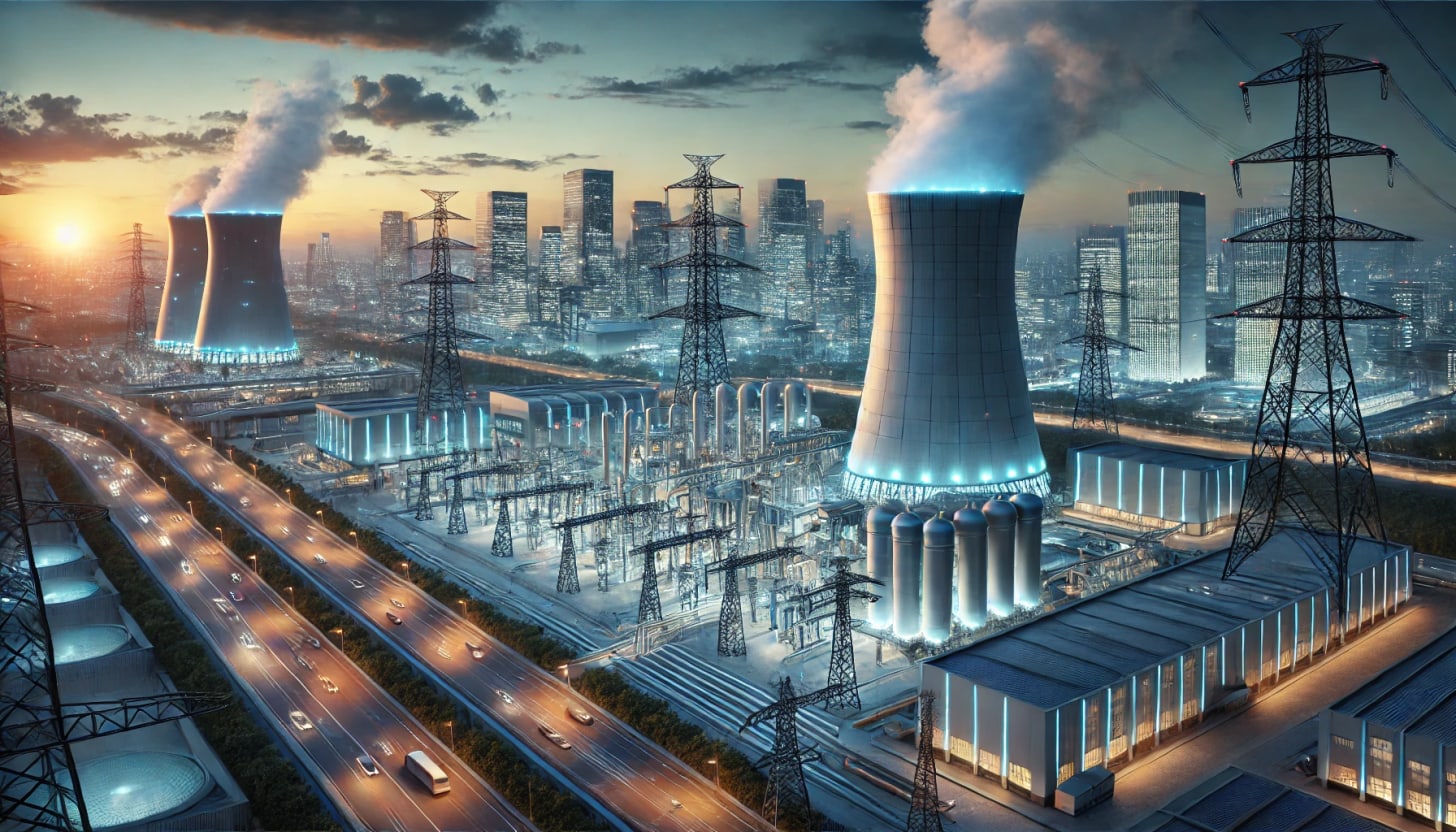Garden Research: Weekly Recap #13
Valar Atomics and Everstar's fix for Nuclear, plus a recap of the seed activity from last week.
Hey Everyone,
Happy Thursday. For those who are new here, every week I deliver a recap of the activity in the US seed ecosystem, a full list of every completed round, and a deep dive into a company I find interesting. If you’re interested in following along, click below.
“The main reason nuclear energy has stagnated isn’t the technology — it’s the way we build and regulate it.”
- J. Storrs Hall
For 70 years, nuclear power has been the cleanest, most reliable source of energy generation on the planet. Look past the stigma and the (actually incredibly sparse) high-profile incidents, and it’s clear that as a species we should look at the nuclear breakthrough as one of our greatest achievements.
High energy density, no carbon emissions, and 24/7 energy production. At risk of being crass, it should be a net-zero enthusiast’s wet dream.
And yet, it’s responsible for just 10% of global energy production.
… Why?
The Nuclear Issue(s)
1) One-Offs
Unlike wind or solar farms, which rely on mass-produced, standardized components that can be rapidly deployed with minimal regulatory friction, every nuclear plant must run a bureaucratic gauntlet before it can be commissioned.
Each plant is a bespoke civil engineering project, forced to adapt to site-specific constraints—seismic conditions, cooling water access, grid connectivity (we’ll get back to that), and evolving safety regulations. As a result, no two nuclear plants are identical.
Take Vogtle 3 & 4 in Georgia: a 15-year odyssey of regulatory shifts, moving targets, and unforeseen site conditions that led to constant redesigns and delays.
2) High Costs
We know how to build nuclear safely, but safety doesn’t mean simplicity. Specialized containment structures, radiation shielding, intricate cooling loops, and multi-layered backup systems demand thousands of custom-engineered components—each adding complexity and cost.
And that’s before a single shovel hits the ground. Licensing, permitting, and engineering costs alone can surpass $500M before construction even begins.
Then, over a 10-to-15-year build timeline, interest payments and inflation pile on billions more in cost overruns.
Case in point: Vogtle 3 & 4 ultimately ballooned to $35 billion.
3) Revenue Generation and ROI
High costs wouldn’t mean much if there existed a quick, guaranteed return on investment. OpenAI is happy to burn $50B a year, because they’re convinced they’ll make it back with quickness once they achieve AGI (still plenty to be skeptical about, but I digress…)
Nuclear doesn’t have that luxury. Most plants operate on razor-thin margins, relying solely on electricity sales to the grid—a slow, incremental revenue stream that can take up to 40 years to recoup initial investment.
Meanwhile, wind and solar costs have plummeted due to exponential improvements in efficiency and manufacturing scale, while grid-scale battery storage has made massive strides in capacity and reliability. Against this backdrop, nuclear struggles to justify itself purely on a cost-effort-investment basis, making it an increasingly hard sell.
4) The Grid. Oh GOD the Grid
Nuclear plants are grid-dependent because they “have to be”. But at the same time, they shouldn’t have to be. They don’t have to be. We’re making them “have to be”. It’s an entirely self-imposed barrier.
Stay with me…
Traditional nuclear plants are tied to the grid because they produce massive amounts of power—far more than a single facility, industrial plant, or local town could ever consume on its own. A typical reactor generates over 1,000 MW of energy every second of the day with no ability to store it. Nuclear doesn’t ramp up or down like natural gas, nor does it fluctuate like wind or solar. It just runs. Constantly.
Since the electricity has nowhere else to go, the easiest—and really the only—solution is to push it into the grid and let the system absorb it.
But this reliance on the grid creates issues.
Location constraints: Nuclear plants must be built near major transmission hubs because their energy output is too large for small or local distribution networks. This means remote or off-grid applications are essentially impossible under the current model.
Grid vulnerability: If a major transmission line goes down, a nuclear plant can be forced to curtail or shut down entirely because it simply has no way to offload excess energy.
Market pressure: In regions with heavy wind and solar penetration, electricity prices can plummet during peak renewable generation, undercutting nuclear’s ability to sell its power profitably—even though it’s one of the most reliable energy sources available.
Meanwhile, gas plants and other fossil fuel generators have the advantage of dialing production up and down as needed, while nuclear is locked into a constant output, regardless of real-time demand. If demand drops but supply stays high, nuclear plants either waste energy or sell it at a loss.
The tech is not the issue. The tech is awesome. The problem lies with the system nuclear has been forced into.
The way nuclear is deployed today makes it entirely reliant on a centralized grid that wasn’t designed to handle it efficiently.
5) The Bureaucracy
I’ve seen Chornobyl on Max. I get it. Super scary stuff. Radiation poisoning = not fun.
But, at the same time, and not to beat a dead horse, the tech works. We know it works. It’s been 40 years, and we’ve only gotten better at the safety thing.
I’m not saying we shouldn’t have strict regulations around nuclear. I am saying we need a better way to navigate the tens of thousands of pages of documentation, years of back and forth with regulators, and outdated approval processes that have barely evolved in decades.
Most of the regulations were written for reactors designed in the 1970s.
We are unnecessarily hindering world-changing technology. And for what reason?
(I’ll let you speculate on that one—we’ve got a lot more to cover.)
Startup Solutions
A couple of weeks ago, two companies raised seed funding to solve two of the most poignant, ridiculous issues surrounding Nuclear.
The broken deployment and revenue generation model.
The broken bureaucracy.
Valar Atomics
Forget the grid. Seriously. Get rid of it.
If the grid is what’s holding nuclear back, why keep forcing it into a system that wasn’t designed for it? Instead of retrofitting nuclear to work within outdated models, Valar Atomics is rethinking it from first principles.
Yes, that phrase is overused in VC and startup circles. Every founder claims to “think from first principles.” Valar actually is.
At its core, nuclear power isn’t about electricity—it’s about heat. Fission generates extreme temperatures, which turn water into steam, which spins turbines, which makes electricity. That’s the model we’ve stuck with for decades. But why? Why not make the heat the product?
Advanced reactors operate at 700-1000°C, well beyond what fossil fuel-based systems can efficiently achieve. And some of the hardest industries to decarbonize—steel, cement, ammonia, petrochemicals—require precisely that kind of sustained, high-temperature heat.
Instead of spending a decade building a reactor, waiting for grid interconnection, and praying the market will pay for nuclear-generated electrons, Valar is deploying reactors directly to industrial sites, where their heat can be used immediately, with no transmission losses and no reliance on the grid.
And then there’s the fuel angle.
Sustainable liquid fuel is the next trillion-dollar energy play, but “green” hydrogen—key to synthetic fuel production—is expensive and inefficient to produce at scale. Meanwhile, natural gas-based hydrogen production emits massive amounts of CO₂, undermining the entire point.
Valar solves this with nuclear-powered electrolysis. Instead of burning fossil fuels, its reactors provide the high heat needed to split water molecules into pure hydrogen. Using Fischer-Tropsch synthesis, that hydrogen can be converted into synthetic jet fuel, diesel, and ammonia—fuels that seamlessly integrate into existing supply chains.
That’s two entirely new revenue models for nuclear—heat and fuel—both of which eliminate grid dependence and create a sustainable, scalable path to ROI.
Everstar AI
For nuclear adoption to reach critical mass, we have to vastly improve the systems of approval, or at least figure out how to navigate it better.
A single nuclear plant requires tens of thousands of pages of documentation, years of regulatory review, and millions in compliance costs before a single watt is produced. Every safety case, environmental impact report, and engineering design must be painstakingly reviewed, revised, and approved by regulators. It’s a process that hasn’t meaningfully changed in 50 years.
Everstar AI is fixing this.
Regulatory friction is nuclear’s invisible tax—one that drives up costs, kills projects before they break ground, and slows innovation to a crawl. Historically, it’s been accepted as an unavoidable reality. Everstar disagrees.
At its core, the nuclear regulatory process is a massive, complex information problem—one that AI is uniquely suited to solve.
Everstar is building AI models trained on decades of nuclear regulatory filings, safety reports, and compliance cases. Instead of armies of consultants manually assembling approval applications, Everstar’s system can automatically generate fully compliant licensing documents tailored to specific reactor designs, locations, and safety standards.
This cuts down regulatory timelines in three critical ways:
Speeding Up Compliance Workflows – Traditional nuclear licensing can take years as teams navigate an endless back-and-forth with regulators. Everstar’s AI streamlines this by automating compliance documentation, cross-referencing past approvals, and flagging potential issues before submission.
Reducing Human Error & Unnecessary Delays – A single mistake in a 10,000-page submission can result in months of review delays. Everstar’s AI ensures complete, accurate filings the first time around, reducing regulatory bottlenecks.
Helping Regulators Work Smarter – Everstar isn’t just a tool for nuclear developers. It also benefits regulators themselves. Reviewing nuclear applications is a painfully slow, manual process. Everstar’s AI can assist with cross-referencing data, verifying compliance, and even suggesting optimizations—allowing oversight agencies to work faster without sacrificing safety.
Right now, the regulatory system was designed for a handful of large plants every few decades. But with the rise of small modular reactors (SMRs) and advanced nuclear designs, we need a process capable of approving dozens, even hundreds of reactors per year.
Without smarter regulation, nuclear will remain stuck in bureaucratic limbo. But with AI-driven compliance, we could see a golden age of rapid nuclear deployment—unlocking the full potential of the technology we’ve had for 70 years, but never fully used.
The Future of Nuclear
For decades, nuclear has been locked into a cycle of incremental improvements—tweaks to existing designs, marginal safety upgrades, and slow, grinding progress.
That’s no longer enough.
Companies like Valar and Everstar are redefining Nuclear’s future, and it’s absolutely necessary.
Valar eliminates grid dependence, transforming nuclear into an industrial heat and fuel powerhouse.
Everstar dismantles the regulatory bottleneck, paving the way for fast, scalable deployment.
This is how nuclear breaks free—not by waiting for the world to change, but by changing the game.
Nuclear is a miracle. Solves almost every “energy” issue. It’s time we start using it.
I’ll be doing a deeper dive into Valar Atomics at some point because the tech, model, and team are cool as hell, and deserve a much closer look than I got to give it here. Keep an eye out.
Last week, 38 companies raised Seed capital in the U.S. (slow week…) 🌱
Quick Stats 📈
Total Funding: $132.9M
Highest Round: $13.4M
Lowest Round: $250k
Average Round: $3.9M
Top Raisers 💰
Goose: Provides an advanced operating system for pet care businesses, streamlining real-time booking, dynamic pricing, and operational workflows. Its platform enhances efficiency by integrating automation and AI-driven insights to optimize scheduling, revenue management, and customer engagement. Raised $13.4M in a round led by BoxGroup, First Round Capital, and Imaginary Ventures.
Archipelo: Delivers a Developer Security Posture Management platform that safeguards software development environments by continuously monitoring risks from human developers and AI coding tools. Its solutions include Developer Detection Response, AI Code Usage & Risk Monitoring, and governance tools to ensure security and compliance across the software lifecycle. Raised $12M in a round led by Dell Technologies Capital.
Tandem: Provides mobile veterinary care, bringing essential pet health services—such as wellness exams, vaccinations, and diagnostics—directly to pet owners. Their platform integrates telehealth consultations and digital health records, making veterinary care more accessible and convenient. By eliminating the stress of clinic visits and offering on-demand care, Tandem Vet modernizes pet healthcare with a more flexible and owner-friendly approach. Raised $10M in a round led by undisclosed investors.
Charta: Leverages AI-driven automation to conduct autonomous pre-bill reviews of medical charts, identifying coding errors and revenue opportunities with high precision. Its technology enhances revenue integrity, prevents denials, and ensures compliance by auditing every chart in real time. Raised $8.1M in a round led by Bain Capital Ventures.
Givinga: Platform enabling businesses to create and manage customized corporate giving programs with seamless integration of charitable contributions. Its technology simplifies donation workflows, enhances employee engagement in philanthropy, and ensures compliance with corporate social responsibility initiatives. Raised $6.35M in a round led by Hasatano Capital.
My Favorites 🕺
Rune Technologies - Raised $6.2M in a deal led by Andreessen Horowitz
Rune Technologies has developed TyrOS, an AI-enabled predictive logistics platform designed to revolutionize military logistics and sustainment operations. TyrOS integrates machine learning for intelligent planning, offering machine-speed evaluations of inventory and transport options, and provides predictive analytics based on historical data and mission parameters. This comprehensive approach addresses the limitations of traditional, often siloed logistics systems by enhancing automation, agility, precision, and real-time decision-making capabilities.
Highstock - Raised $5.5M in a round led by Greylock
Highstock is a technology platform that connects brands with unsold inventory to vetted global wholesale buyers through a private marketplace. The platform ensures total privacy, allowing sellers to maximize recovery rates and preserve brand value, while buyers gain access to desirable products at exclusive prices. By streamlining the distribution process and offering flexible payment terms, Highstock differentiates itself by providing a secure, efficient, and mutually beneficial environment for both buyers and sellers in the global distribution landscape.
Finisterra Labs - Raised $3.75M in a round led by Haun Ventures Management
Finisterra Labs is pioneering decentralized data infrastructure with its platform, Baselight, which serves as a universal hub for structured data. Baselight enables users to list, share, and monetize data through trustless transactions, offering powerful analytics capabilities without the need for additional infrastructure. By fostering a community-driven approach that rewards contributions through data bounties, Finisterra addresses the challenges of data accessibility and monetization, setting itself apart with a focus on openness, transparency, and user empowerment in the data ecosystem.
SimCare AI - Raised $2M in a round led by Drive Capital and Y Combinator
SimCare AI leverages artificial intelligence to create realistic, interactive patient simulations aimed at scaling healthcare training. Their platform allows students and professionals to engage in AI-simulated conversations with patients, facilitating practice and evaluation anytime, anywhere. By replacing traditional, resource-intensive training methods with scalable AI solutions, SimCare AI enhances the efficiency and effectiveness of clinical training, providing a legal and practical alternative that meets accreditation requirements and expands training capabilities without compromising quality.
Lantern Finance - Raised $1M in a round led by Orange DAO and Andover Ventures
Lantern Finance offers a crypto-backed lending platform that enables users to borrow funds against their cryptocurrency assets without the need to sell them. With a security-first approach supported by industry-leading custodians like BitGo, Lantern provides loans with competitive interest rates and flexible terms. The platform also offers staking services, allowing users to earn rewards on their idle crypto holdings. By combining robust security measures, ease of use, and regulatory compliance, Lantern Finance differentiates itself as a trustworthy and efficient solution for individuals seeking to leverage their crypto assets for financial needs.
You can find the full list of startups that raised seed capital last week linked here
Seeya next week!












